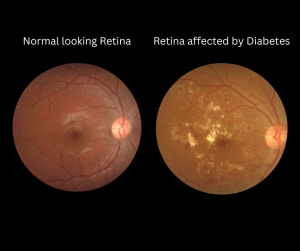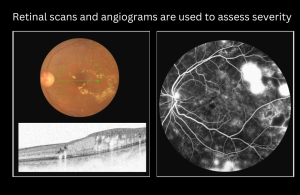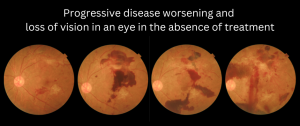QUICK LINKS
Diabetic Retinopathy
What is Diabetic retinopathy?
When diabetes is present for a long time, the retina begins to develop some changes which could include swelling and bleeding. This is known as diabetic retinopathy. When bleeding and swelling increases, an individual can perceive floating objects in his vision or the vision may be dull and defective. In advanced cases, vision may be completely lost because of these changes. This is known as diabetic retinopathy.

Does diabetic retinopathy cause blindness? What can be done to treat the disease?
Diabetic retinopathy is one of the leading causes of blindness. If you have diabetes, annual eye check-ups are strongly recommended. Your retina specialist will check your eyes and, if necessary, perform a few scans. Thereafter the specialist will take a call on the treatment required
In some instances, although retinopathy is present, immediate treatment is not required and the retina specialist will ask you to come for follow-up at specified time periods. If treatment is required, the choices are between injections in the eye, laser to the retina and retina microsurgery. These treatments can be done separately or in a combination mode. Therapy usually involves multiple sittings and continuous monitoring.

I am diabetic for 5 years and my blood sugar has always been under control. Do I really need retina check-up?
It is important to remember that Diabetic retinopathy is the most common micro vascular complication of diabetes and EVERY DIABETIC patient is at risk for developing retinopathy. Good sugar control is essential in every diabetic patient. However, even with good control, patients do develop diabetic retinopathy because of the duration of the disease and other genetic factors. It is best to see an eye doctor when VISION IS NORMAL. This helps to detect retinopathy in early stages when damage to retina is minimal and save good vision.
Diabetes causes damage to many organs due to its continuous activity in the body. Retinal damage is not because of “present” sugar level. So when there is vision loss, it does not necessarily mean that blood sugar level should be high at that point.
It is a natural tendency to get our body checked only when there is a problem. However, in relation to diabetic retinopathy, the disease could be present in a milder form long before vision reduces and treatment at this stage is most useful. The adage “Prevention is better than cure” is very apt for diabetic retinopathy.

How many injections are needed to cure one’s diabetic retinopathy?
The eye injections are given to treat swelling and / or bleeding in the eye. There are many factors like severity of the disease, type of medicine taken and response of the retina to a particular medicine that determine the duration of treatment and number of injections. Hence, it is difficult to predict the number of injections an eye will need. Since diabetes is a continuing disease in the body, it is better to be prepared for repeat injections to stabilise the disease process.
My doctor mentioned that I have diabetic retinopathy three years ago. Will it progress? Should I check my retina again?
Yes. Every diabetic patient is advised to get his or her retina checked by a specialist once a year. The disease that was at a very early stage can gradually progress while the vision remains normal. It is important to recognise the progressing disease when vision is normal and at this stage, early treatment will help to prevent any major damage to the retina.
One of my cousins had laser for diabetic retinopathy three years ago. Recently, his vision decreased and he was advised retina surgery for the same condition. Why does he need multiple treatments? Is a single treatment insufficient?
Diabetes is an on-going disease in the body. One does not take medicines or insulin injections for a month and then stop treatment. Similarly, treatment of retinopathy in the eye using injections, laser or surgery is aimed to stabilize the disease and prevent progression.
However, there can be fluctuations in the disease condition based on general status and sugar levels. Lifting weights or straining can also cause bleeding. Based on the dynamic scenario within the eyes, additional treatment may be required
Retinal surgery has evolved rapidly in the past few years. Generally, surgery for diabetic retinopathy is recommended when lasers or injections would no longer be sufficient to restore or maintain the vision. These surgeries tend to be complex and time consuming but are very helpful in patients who have either bleeding in the eye and or retina detachment due to traction in advanced diabetic retinopathy.
